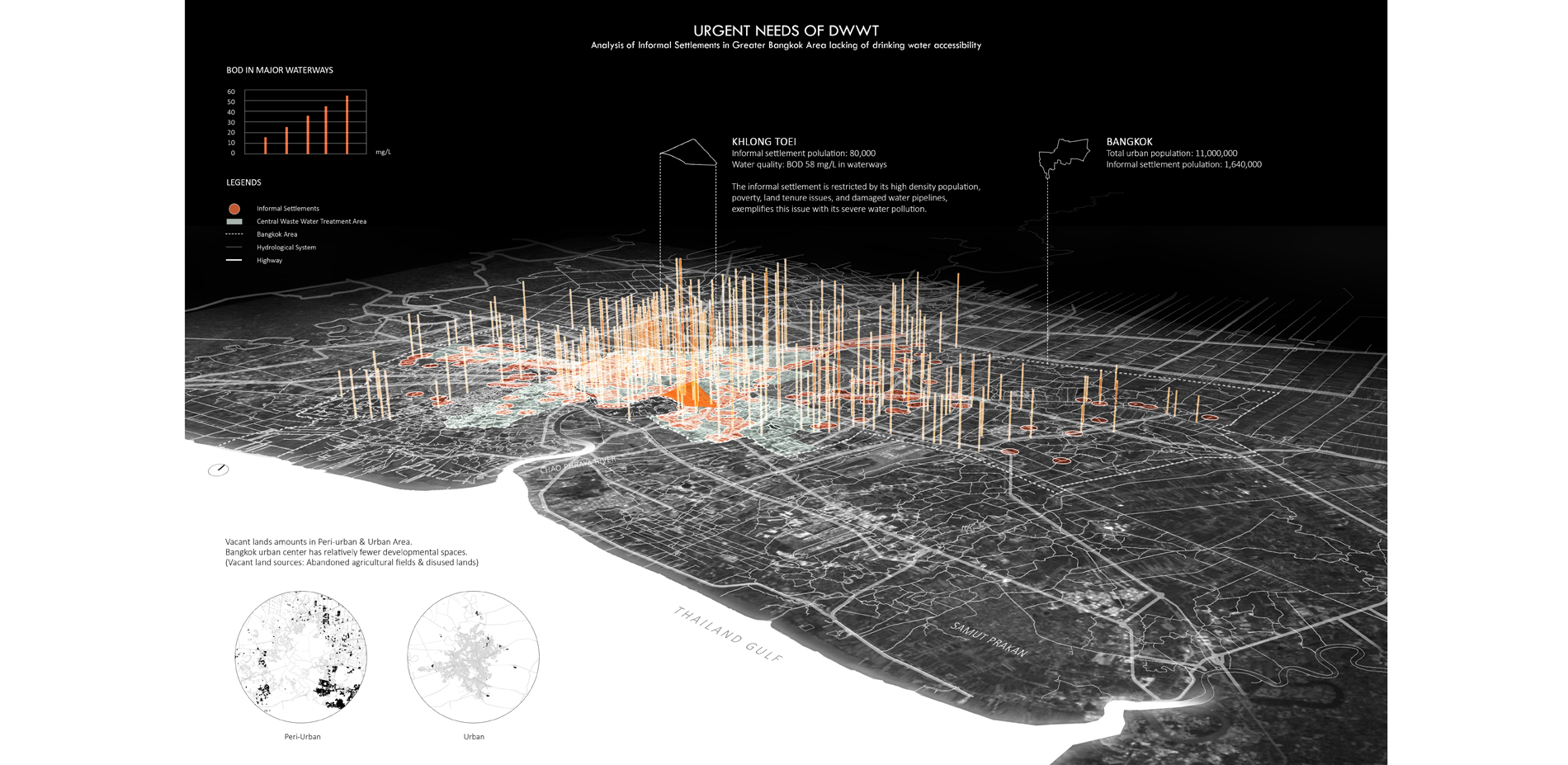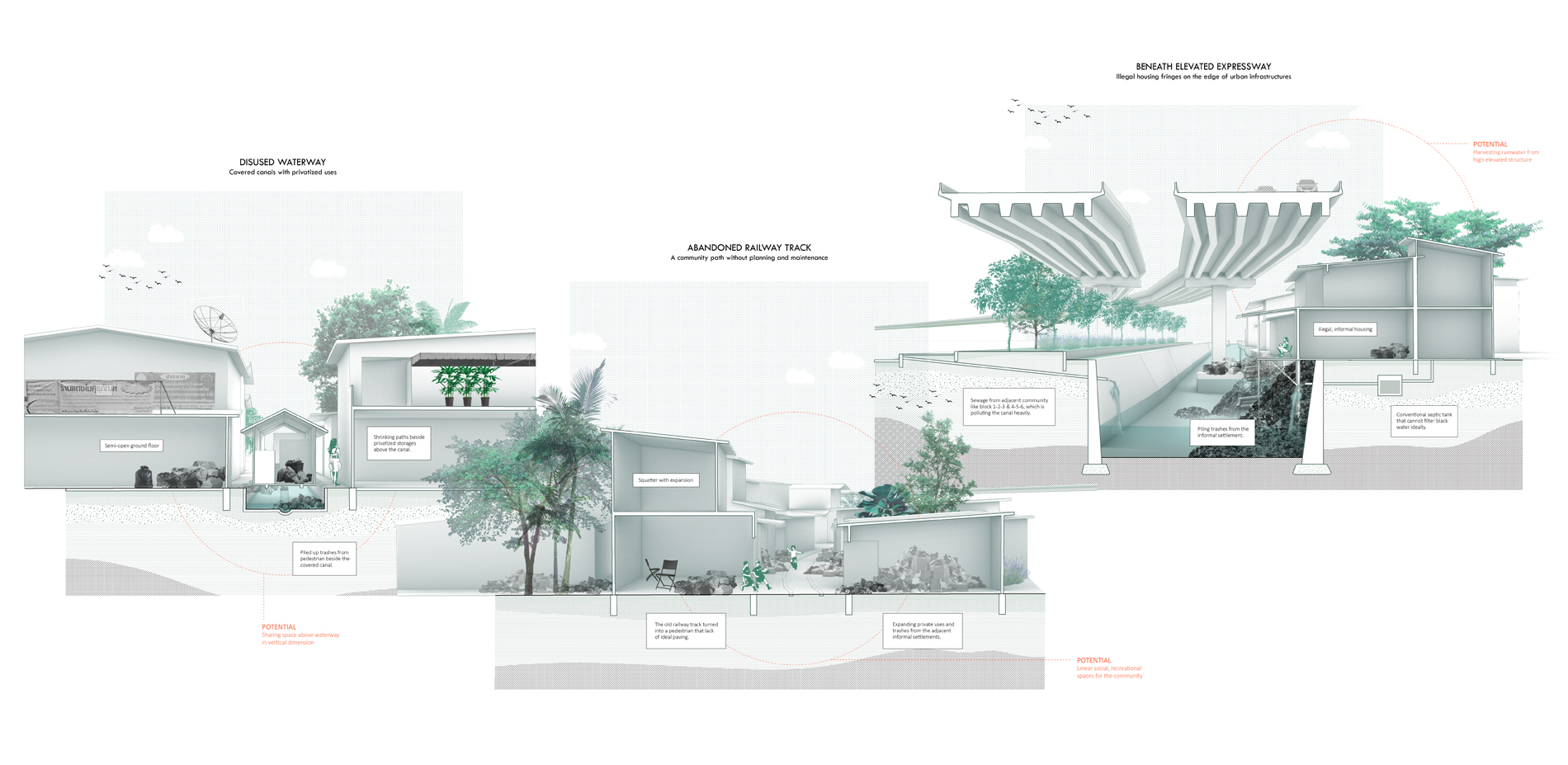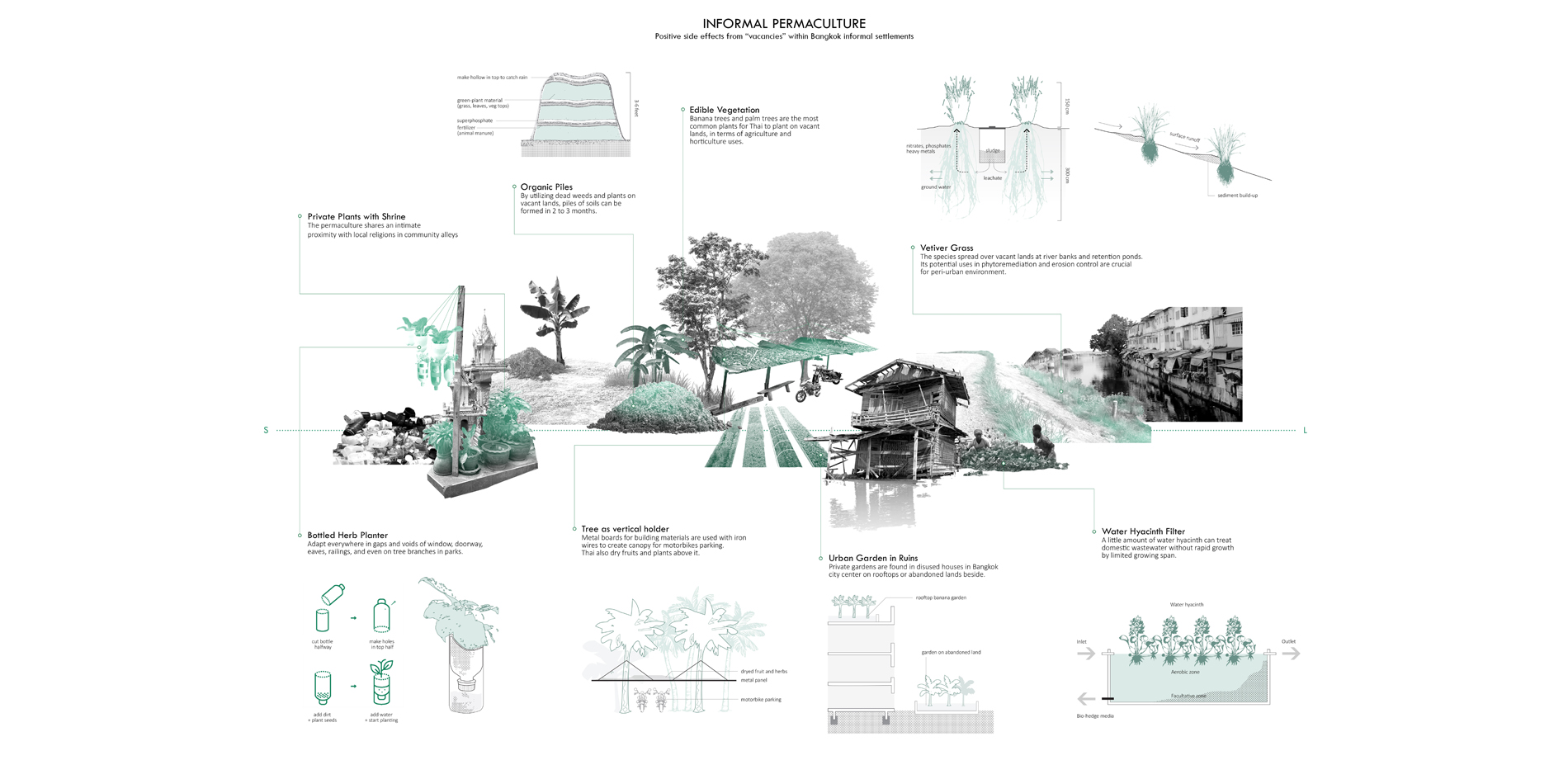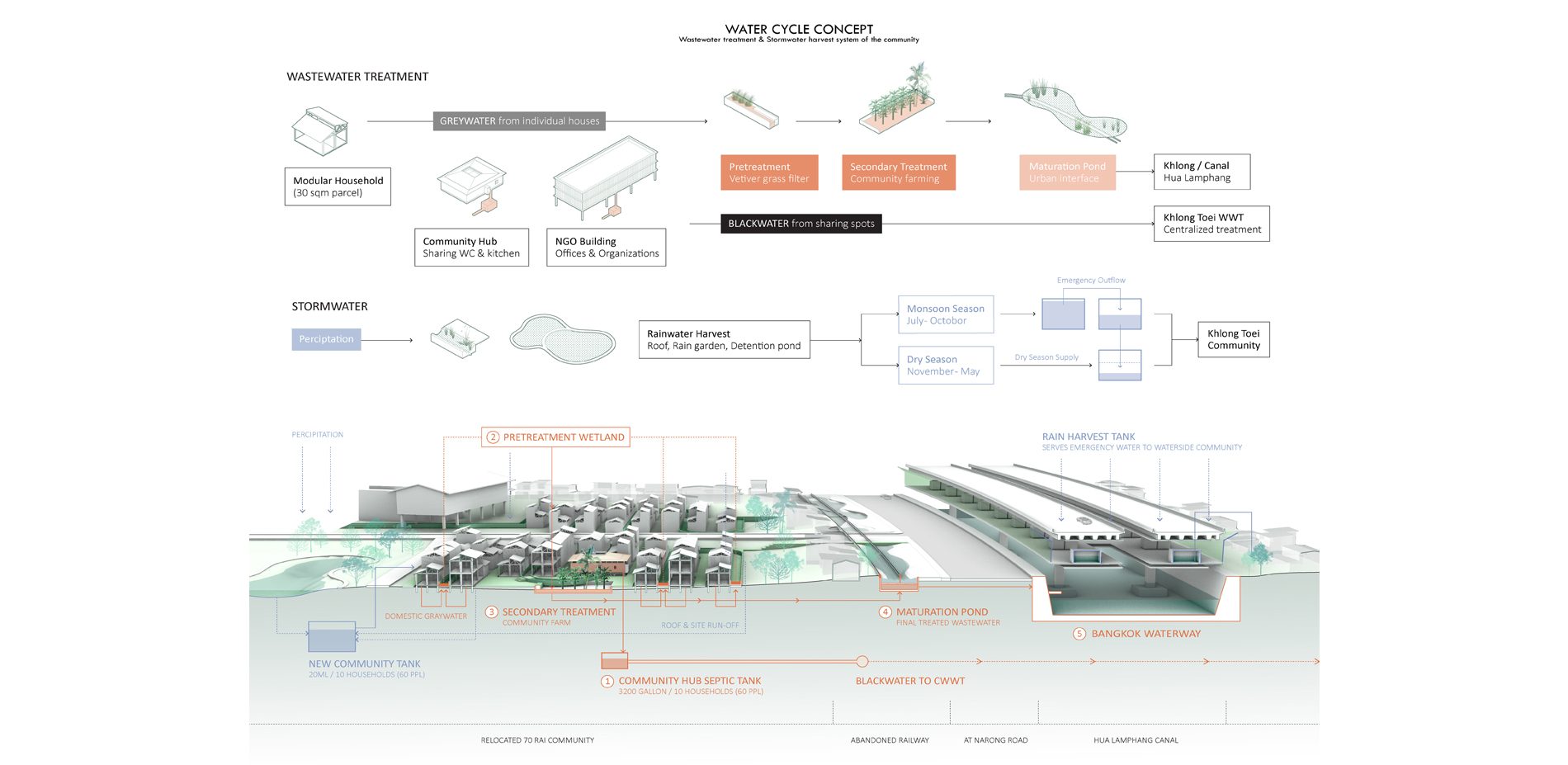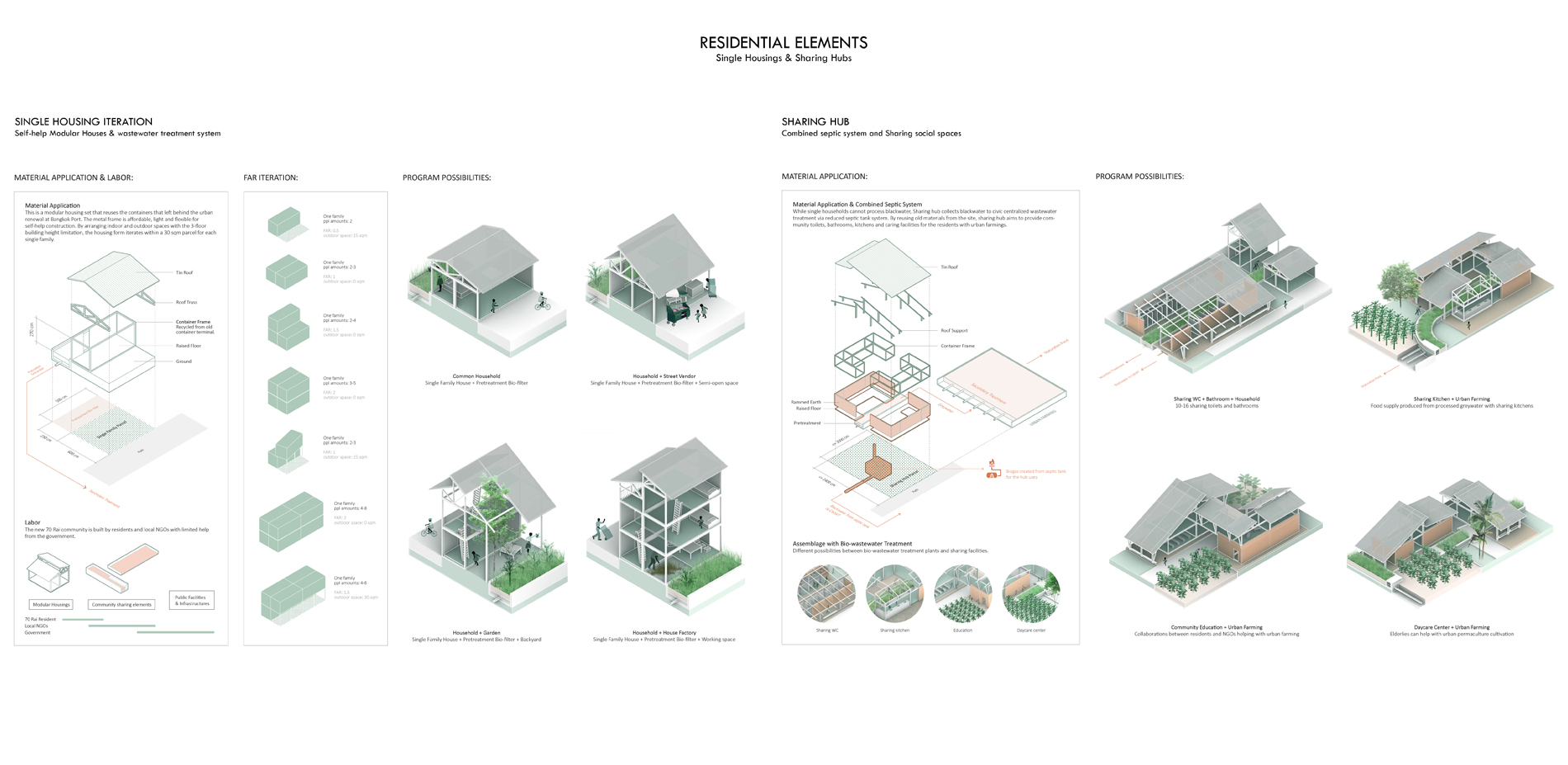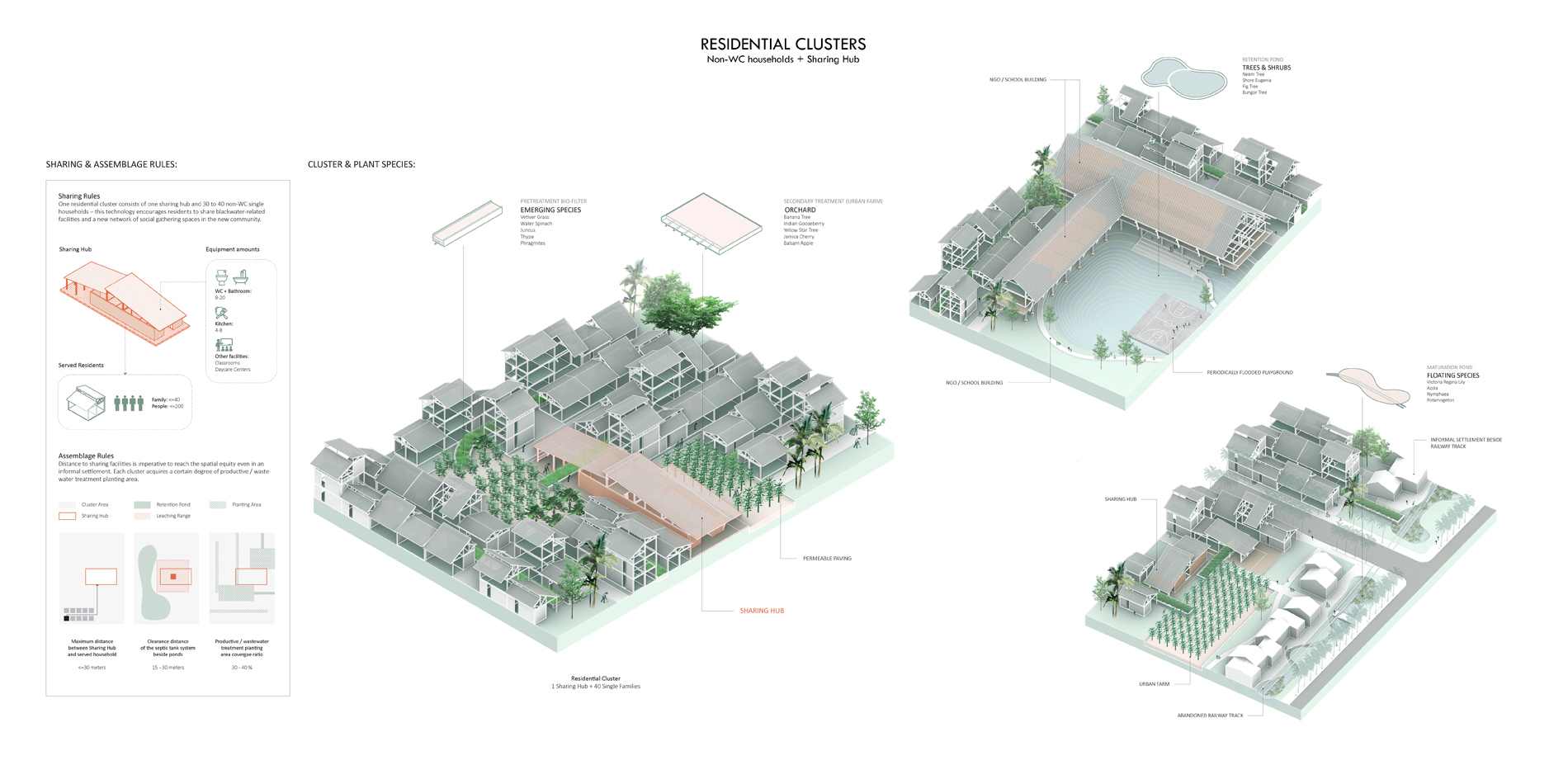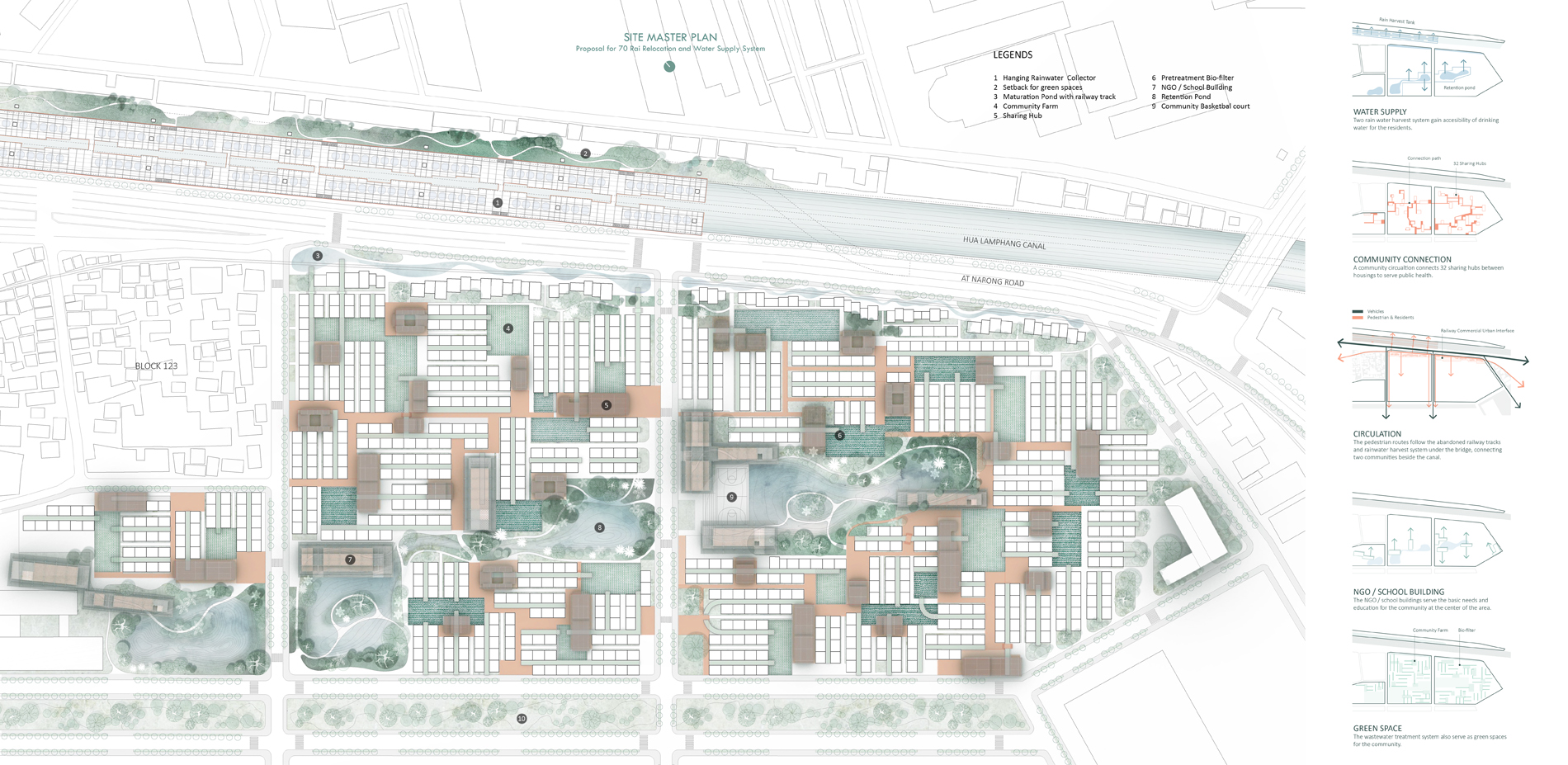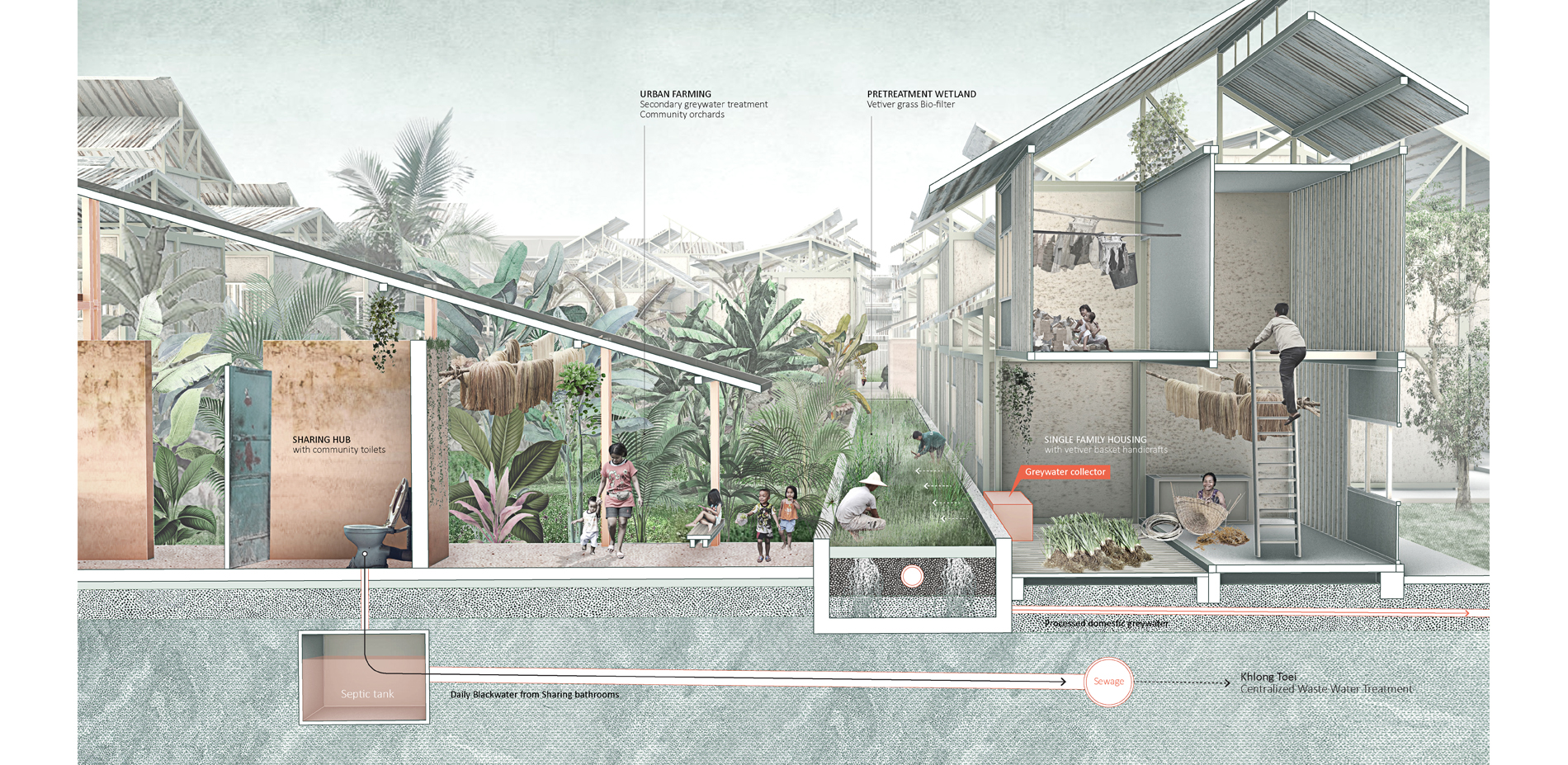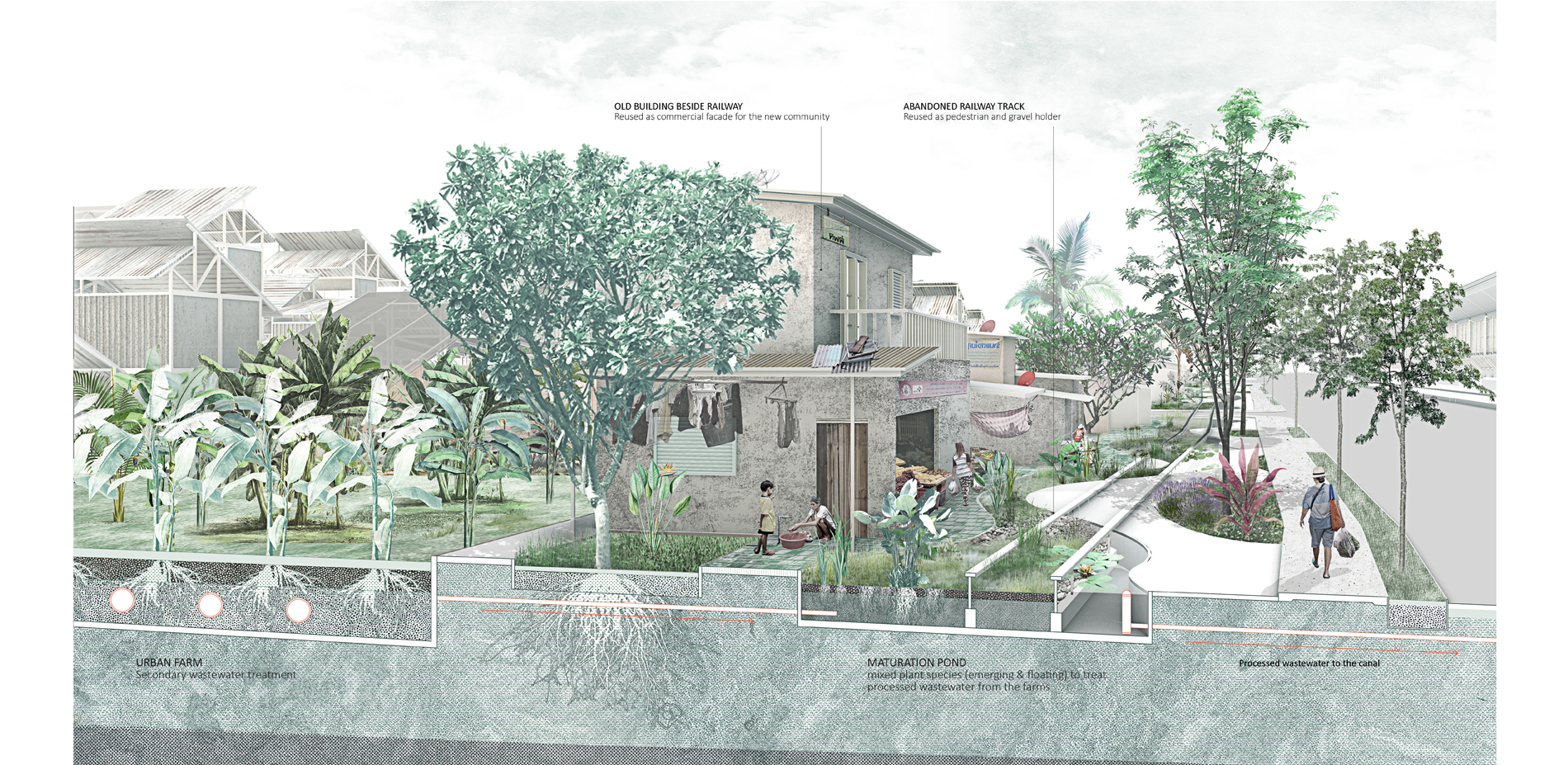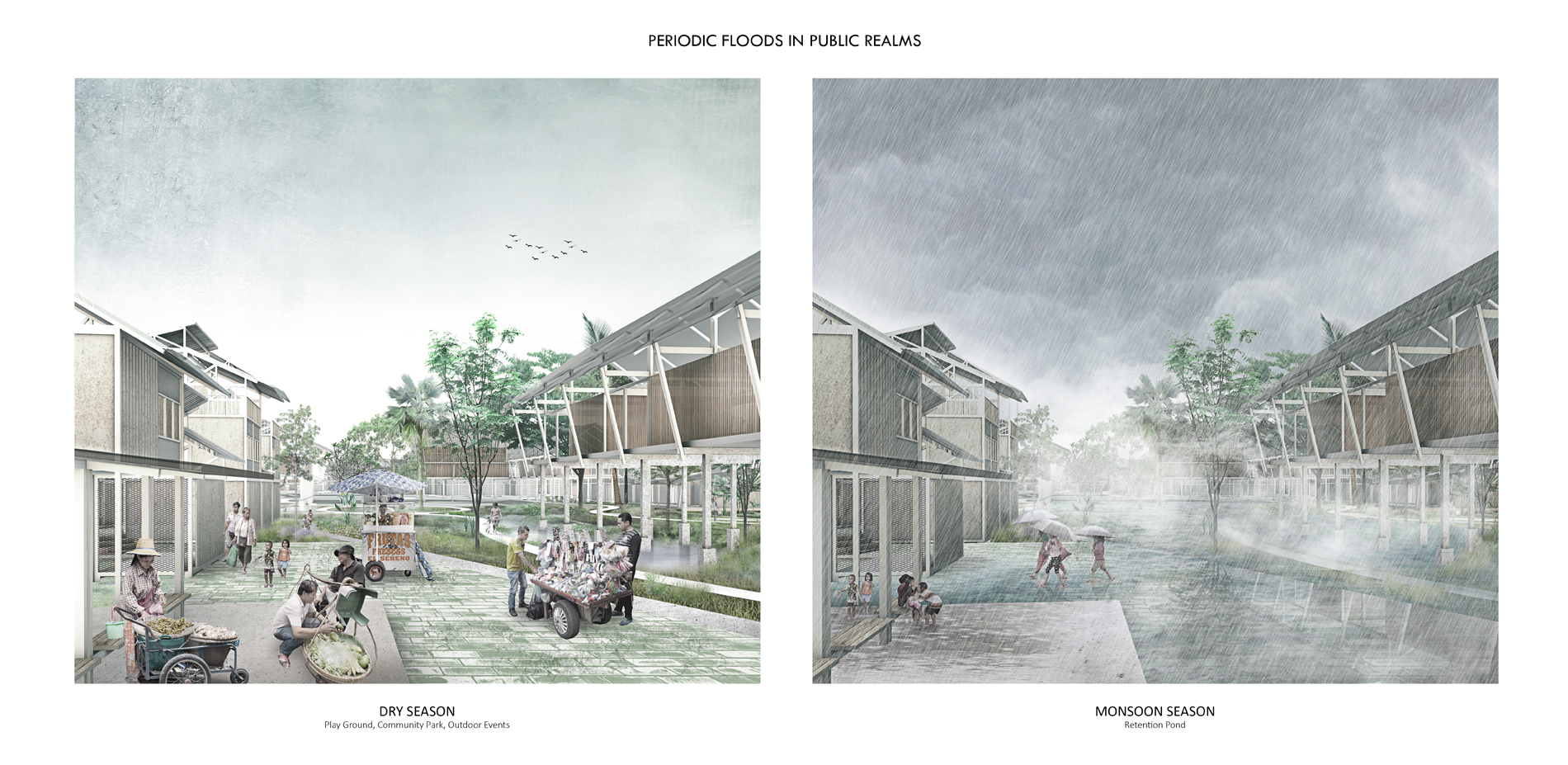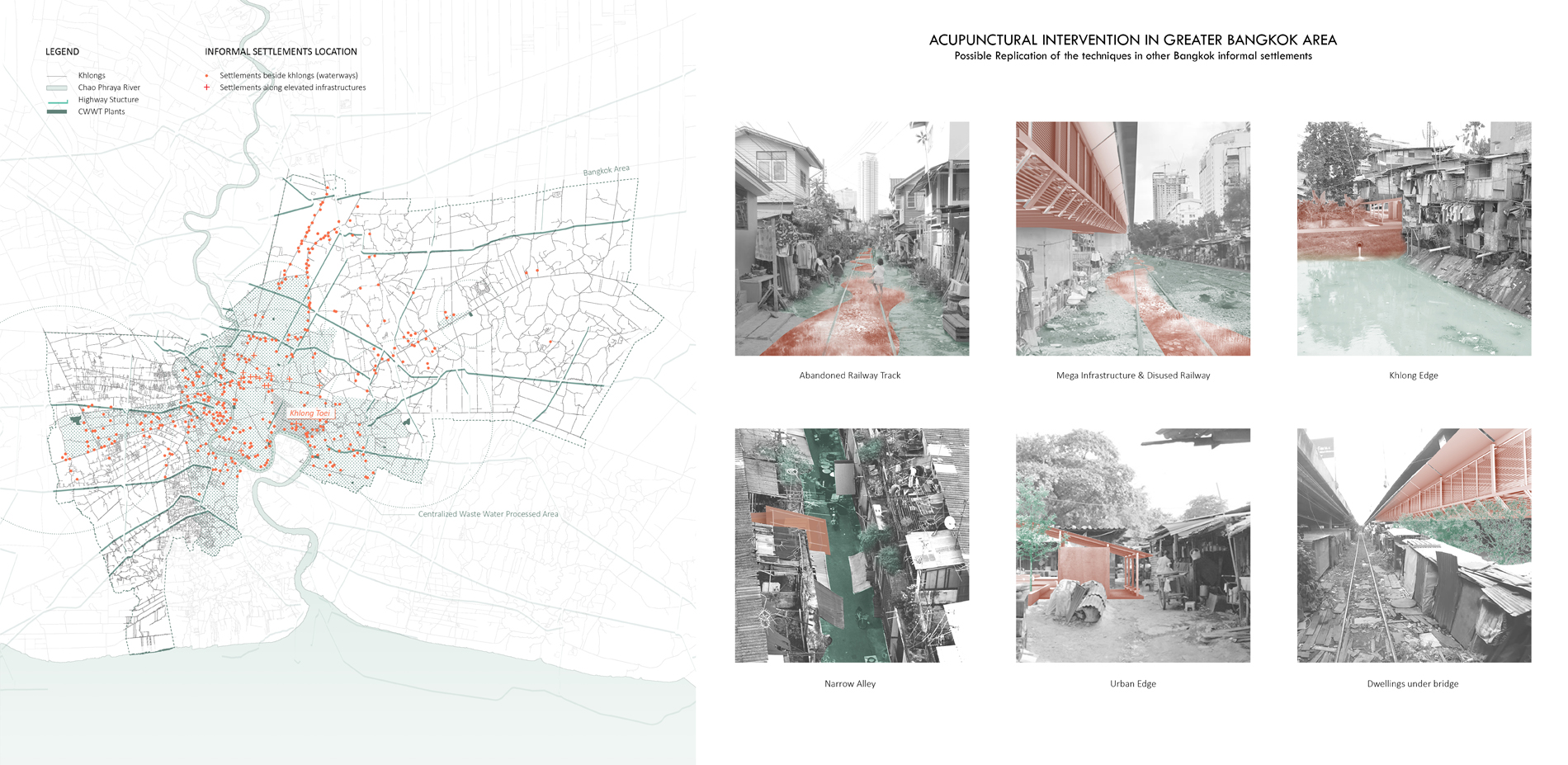Informality as Filter: A Renewed Land Sharing Plan for Khlong Toei Community
Award of Excellence
Residential Design
Tina Yun Ting Tsai, Student ASLA
Faculty Advisors: Niall Kirkwood, FASLA; Kotchakorn Voraakhom, ASLA
Harvard University Graduate School of Design
Bangkok’s Khlong Toei community—an informal settlement along one of the city’s many canals—suffers from contaminated water, degraded health conditions, and the constant threat of relocation. But if this impermanent community were made a permanent and planned part of the city, as this project proposes, a mutually beneficial arrangement between inhabitants and city government could blossom. Starting with a multi-functional infrastructure of shared toilets feeding a wastewater treatment plant, greywater would be generated for use in community orchards. A retention pond and storage tanks would collect excess monsoon rainwater to be used during the drier months. By addressing this community’s needs, rather than shunting it to another temporary location, the local government would advance social equity while improving urban hygiene through a new, sustainable ecology.
- 2020 Awards Jury
Project Statement
This project aims to redefine Bangkok informal settlements as a means to tackle urban sanitary and flooding problems. The study site --Khlong Toei Community is the largest complex of Bangkok informal settlement and is currently facing issues such as population density, lack of accessibility to drinking water and eviction from Port Authority of Thailand (PAT). Instead of massive relocation, the intervention of a new land sharing plan that improves water supply and self-help food production will propel “in-depth tourism” that preserves local culture and “the right to stay with mutual benefits” between the city government and local residents.
Project Narrative
[ The complex of Bangkok informal settlements ]
Because of its myriad hydrological system on the Lower Chao Phraya floodplain, Bangkok is known as the “the Venice of the East”. Despite the mixture of a great civilization and agriculture industry that derived from the highly disturbed khlong (local canal) system, the waterways are currently heavily polluted by rapid urbanization and immense levels of urban wastes. While the Thai livelihood used to be closely tied to the khlongs, the waterways ended up as open-air sewers where 60% of the pollution sources come from adjacent unprocessed domestic wastewaters.
Similar to most of the khlong-side informal settlements in Bangkok, the Khlong Toei Community is located in the heart of the capital, where lands owned by the Port Authority of Thailand (PAT). In the 1930s, people from peri-urban were attracted by terminal employment with a low-cost land rent system. After the second eviction from PAT, the Land Sharing Plan made an agreement between PAT and National Housing Authority (NHA), while PAT occupied a third of former squatter land to build its container terminal, with an area of 70 Rai leased to NHA for a 20-year period, subdivided into regular blocks and rented to residents. Though the residential quality was improved and secured by more infrastructures and building materials supply, the swamp substrates and degrading water qualities kept threatening the community health. What is worse, due to the impending eviction, the entire Khlong Toei community will be replaced with a commercial district, by depriving their harbor jobs and moving them into a remote 26-floor public housing tower. Opposite to the governmental plan, my project -- Informality as Filter proposes a renewed land-sharing plan with wastewater infrastructure that is adaptive, productive, and poly-functional, opening the enclosed community to more public awareness that could help change their fates.
Known as the biggest informal settlement in Bangkok, Khlong Toei has attracted international tourists all over the world. In Khlong Toei Community, the squatters live informally in three civic infrastructure space types: abandoned waterway encroachment, derelict railway track, and vacant lands beside khlongs under highways. Sharing a similar linear narrow form that cannot be easily developed, those types are very common in the Greater Bangkok Area.
[ Renewed Land Sharing Plan & Wastewater Treatment ]
Rather than relocating the entire community, by moving 70 Rai to the north-eastern proportion of the community, PAT can own a more regulate land for future commercial development. The newly relocated 70 Rai community serves as a threshold to filter domestic wastewater that preserves local culture and right to stay with mutual benefits between government and residents. To harness this new “filter”, the whole wastewater treatment process includes a sequential order of sharing toilets, pretreatment bio-filter, secondary treatment (community farming), and maturation ponds. In addition to boosting civil water quality, these adaptive elements serve as a poly-functional infrastructure when gathering blackwater and treating greywater for community agricultural uses. The concept of “sharing” is emphasized within the new community: while residents can share public toilets, kitchens, classrooms, and daycare facilities, they take care of community orchards and maintain the wastewater-driven economy. For example, vetiver grass plays a vital role in the pretreatment bio-filter (subsurface flow wetland) by offering phytoremediation and raw materials for the domestic industry simultaneously. Other valuable exports from the secondary treatment orchards include banana, balsam apple, star fruit, and several kinds of vegetables savored in iconic Thai cuisines and street foods. Finally, before the processed wastewater reaches the khlong, pathogens are removed in the maturation pond that is combined with the abandoned railway track on the edge of At Narong Road, representing a commercial façade that welcomes external visitors and pedestrians.
Besides wastewater treatment, the community’s irrigation and potable water come from strategic rainwater harvesting techniques that suit Bangkok’s tropical monsoon climate: retention pond and hanging rainwater collector. During the rainy season from July to October, the extra amount of stormwater will be storage in emergency tanks that can subsidize necessary needs in dry seasons. Due to the delta geology and high groundwater level, instead of using conventional buried water tanks, a hanging rainwater collector is an ideal alternative that can utilize empty voids beneath elevated highway structures to stabilize rainwater panels and pipelines. Other than providing clean water to adjacent dwellings, the harvest system includes a semi-open urban platform that renders public events like outdoor market and recreations with shade, subsequently close the circulation gap from the khlong below. What is more, it can turn into a continuous urban cooling system with a few amount of stored water, which is a great gift to Bangkok, especially during scorching hot days.
[ Residential Plan: Modular Housing and Sharing Hub ]
In 70 Rai, there are around 1,300 families, and the average number of people per family is 5. Instead of relocating them in high rise affordable housing, which is not suitable and affordable on soft grounds, a strategical layout of modular housings and sharing hubs will renew the current settlement style. Cooperation from government and local NGOs such as Mercy Centre, the wastewater infrastructure will be implemented first to supply basic needs. By reusing the terminal containers that left behind the urban renewal at Bangkok Port, the new modular housings are built with self-help metal frames. Single housing iterations are set on grids of 5 x 6 meters, allowing for modifications in terms of FAR or height with the 3-floor limitation. By adhering to the vetiver grass bio-filter, each non-toilet housing can process and recycle greywater for permaculture uses. To offer a new network of social gathering spaces as a relief from the disused pathways and waterways, a residential cluster consists of one sharing hub and 30 to 40 non-WC single households. In the past, the Khlong Toei community was threatened by a high rate of waterborne diseases from polluted water sources. With a 30 meters distance of the maximum distance between sharing hub and served household, and a 30 meters clearance distance of the septic system, the assemblage rule assures the social equity that provides curative health care and well-being to the community.
[ Future Vision ]
Informality as Filter offers hybrid landscapes that filter domestic wastewater with phytoremediation and foster cultural relationships with connected productive ecologies. The poly-functions root in the water retention and remediation techniques, creating a variety of social gathering spaces with hierarchies that range from community parks to urban pedestrians. Finally, the replicable techniques allow similar informal settlements and “negative” urban vacancies to revitalize with the acupunctural intervention of the filters. Starting as a huge experimental field at Khlong Toei community, more “informality” in Bangkok can be preserved through landscape infrastructure that goes beyond technological imagination to address issues of sustainable ecologies, urban hygiene, and social equity.
